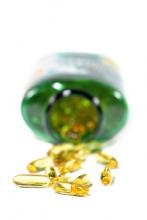NEW ORLEANS – Calcium and vitamin D supplementation has been associated with a 50% lower risk of melanoma in postmenopausal women at increased risk due to a history of nonmelanoma skin cancer.
Of note, this apparent protective effect against melanoma was confined to the 6% of women in the randomized, prospective trial who had a history of nonmelanoma skin cancer. Daily supplementation with 400 IU of vitamin D and 1,000 mg of calcium for 7 years had no impact on the rate of nonmelanoma skin cancer in the overall study population of 36,282 postmenopausal women. And supplementation showed only a nonsignificant albeit favorable trend for fewer melanomas in the full population, Teresa Fu reported at the annual meeting of the American Academy of Dermatology.
A separate line of evidence suggesting a protective effect for vitamin D against melanoma came from a subanalysis of 4,868 Women’s Health Initiative (WHI) participants for whom baseline serum vitamin D levels were available. One-third of these women had a serum vitamin D of 30 ng/mL or above, considered by many authorities to be clinically sufficient. Women in the lowest tertile for serum vitamin D, with a level below 20 ng/mL, had a fivefold higher incidence of melanoma during 7 years of prospective follow-up than did those in the top tertile, and women in the intermediate tertile had a fourfold greater incidence, according to Ms. Fu, a medical student at Stanford (Calif.) University.
Two years into the trial, mean serum vitamin D levels in the supplement group had increased by 28%.
A limitation of this WHI analysis is the low number of melanomas that occurred during 7 years of follow-up. There were only 27 cases of melanoma among the 4,868 women with baseline serum vitamin D levels available, and 176 in the full study population of 36,282 postmenopausal women.
Another limitation is that the skin cancer analysis was post hoc. The WHI calcium/vitamin D trial was designed to assess whether supplementation affects the risks of hip fracture and colorectal cancer. Ms. Fu and coworkers in the Stanford dermatology department decided to look at skin cancer rates in the WHI because several laboratory studies have shown vitamin D has antiproliferative and pro-differentiation effects on skin cancer cells, she explained.
Session chair Dr. Richard L. Gallo, a coauthor of the recent Institute of Medicine report (pdf) on vitamin D, said that "the suggestion in the WHI that lower vitamin D serum levels have a higher associated risk of melanoma is very intriguing and exciting."
A key recommendation in the report involves the need for more data on the use of vitamin D in cancer prevention, so the new WHI analysis is most welcome, added Dr. Gallo, professor and chief of dermatology at the University of California, San Diego.
Ms. Fu said one of the motivations for her study is that despite the fact that roughly 68,000 new cases of melanoma are diagnosed annually in the United States and the malignancy is responsible for 8,700 deaths per year, as yet there is no consistently effective prevention strategy.
The WHI was funded by the National Heart, Lung, and Blood Institute. Ms. Fu’s analysis was supported by the Stanford Medical Scholars Fellowship and the American Skin Association. She declared having no financial interests relevant to the study.


